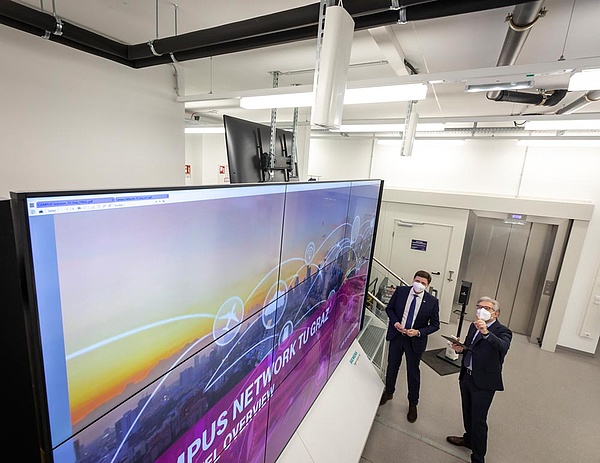Franz Haas looks at the experimental smart factory @tugraz on Infeldgasse in Graz. A lot has happened here in recent months – far beyond the installation of two new small antennas in the room, the dean of the School of Mechanical Engineering explains: It is a full-fledged so-called campus 5G network and will be used for future research. ” The focus is on the topics of fast and secure data transmission, functional occupational safety, system reliability, and innovative production and automation systems. “With our new 5G network, we see ourselves as an incubator for new application ideas and want to execute exciting projects with partner companies of all sizes and industries.”
5G is the successor to the previous mobile communications standard 4G. Previously it was a frequency range between 3. kHz and 6 GHz Used for data transmission in mobile communications. 5G extends this range up to 300 GHz. This means more data can be transmitted in a shorter amount of time with significantly lower transmit power. This is of particular interest for areas such as the Internet of Things, highly automated production, and autonomous driving, where large amounts of system-critical real-time data are generated.

Franz Haas (left) and Rudolf Pichler inspect a 5G antenna (top) at the smartfactory@tugraz pilot factory. © Lunghammer – Graz University of Technology
Possible applications and new ideas
As Franz Haas explains, the possible applications are wide-ranging. “5G will allow data to be processed and transmitted in near real-time, which will greatly improve the safety of production facilities.” For example, the new standard will require data goggles worn by employees. is fast enough to immediately display hazard warnings through the 3D 300V or send an emergency stop command to the machine in the event of a major failure. “Safety remains a key issue and 5G could make a big difference here,” say the researchers.
In addition to safety, Haas sees great development opportunities in machine vision. The first project is currently equipping employees with data goggles to accurately record production tools, detect and avoid operational errors early, and facilitate maintenance tasks. “At Graz University of Technology in particular, image processing is a field,” says Haas, citing the Institute of Computer Graphics and Vision as an example.
New mobile communications standards also open the door to new worlds in the field of virtual and augmented reality. Designers can use the headset to immerse themselves directly in their designs and go “in-depth” in the truest sense of the word. “Currently, data glasses are only able to perform the rendering required for this with great effort due to hardware limitations. However, with the help of 5G technology, we can perform these large-scale computing tasks. , we will be able to send and receive data to the cloud for processing, in real time,” Haas said. This leads to a whole new world of co-design of machines and entire factories.
Regarding data security, we are nearing a partnership with SGS. In February 2019, the global market leader in the field of product testing, validation, inspection and certification, as well as IT security assessment, opened a cybersecurity campus in collaboration with Graz University of Technology in the immediate vicinity of Campus Infeldgasse. Founded in Graz. Smart Factory @tugraz. “Initial discussions have already taken place and strong commitments have been made to work closely together,” Haas summarizes.
Smartfactory@tugraz’s 5G network was implemented in cooperation with mobile communications provider T-Mobile Austria GmbH and with funding from the City of Graz, the Chamber of Commerce and Industry and the State of Styria.
lowest radiation exposure
In addition to many possible applications, we will also cover topics that are widely discussed in public: 5G and health. Shortwave radiation is more susceptible to interference than the traditionally used longwave radiation and can be affected by stone walls and heavy rain. Therefore, you will need significantly more transmitters than before. However, these transmitters are also much smaller and operate with lower transmit power than current transmitters. This means new transmitters will be closer to where people live. This has raised health concerns among some citizens.together Auba, Haas hopes to conduct a long-term study of radiation exposure from 5G here. “In particular, we consider how the different transmit power levels of the antennas affect each other. Also, the large number of transmitters means that transmitters that are currently not fully used can be switched off. It is also important to note that this means that it can be operated in reduced mode or in reduced mode.The overall radiation exposure is now even lower than before.”
Research together and shape the future
Rudolf Pichler and Franz Haas, who are currently responsible for the smartfactory@tugraz pilot factory, are inviting companies of all sectors and sizes to get in touch. “We want to work with them to define innovative ideas for projects related to 5G applications and enable us to translate this new technology into business reality. Our 5G campus network With this, we are a pioneer throughout Austria and are leveraging the experience from our partners at RWTH Aachen University’ universities and other locations. ”


